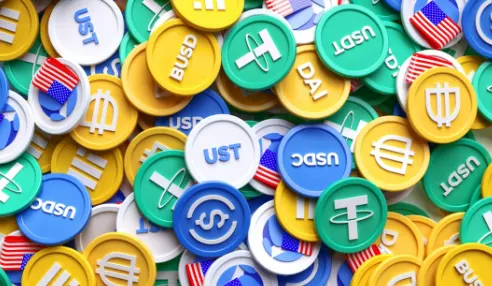Tether is launching Alloy (aUSDT), a gold-backed stablecoin pegged to the U.S. dollar. It is designed as a synthetic dollar and allows holders to retain exposure to gold while using a dollar-referenced asset for transactions. Meanwhile, Uphold crypto exchange will delist six stablecoins, including USDT, in Europe due to the EU's new MiCA regulation. In realted news, former U.S. House Speaker Paul Ryan recently shed some light on stablecoins' potential when it comes to preserving the U.S. dollar's global dominance and alleviating the debt crisis.
Tether Launches Alloy
Tether has introduced a new gold-backed stablecoin called Alloy (aUSDT), that is pegged to the U.S. dollar. The new coin can be minted on the Alloy by Tether platform and is overcollateralized by Tether Gold (XAUt), which represents ownership of physical gold. Despite being pegged to the U.S. dollar, Alloy is considered a synthetic dollar, and is designed to mimic the value and functionality of the U.S. dollar without direct backing.
In a post on X, Alloy explained that tethered assets aim to track the reference price of another asset through various stabilization mechanisms. The platform provides long-term holders the opportunity to maintain exposure to gold while simultaneously using a dollar-referenced tethered asset for everyday transactions.
Other tethered assets, including yield-bearing products, can also be created on the platform. Users can mint the synthetic dollar by depositing XUSDT through a smart contract and price oracles. Users can then make transactions with aUSDT while retaining their gold-backed Tether asset.
Alloy by Tether was developed by Tether subsidiaries Moon Gold and Moon Gold El Salvador, and will be part of a real-world asset tokenization platform launching later this year, according to Tether CEO Paolo Ardoino.
This new asset is not the first synthetic dollar. Iin August of 2022, Galoy introduced Stablesats, which was a Bitcoin-based synthetic dollar on the Lightning Network. The concept really became popular when Ethena Labs launched its Ether-backed, dollar-pegged USDe in February. This was followed by Asymmetry's algorithmically balanced synthetic dollar in June.
Some analysts have compared aUSDT favorably to USDe and other stablecoins, and pointed out that Tether’s high liquidity and centralized control reduces principal-agent risk. To incentivize adoption, Tether is offering USDT holders a bonus at a 2:1 ratio and has allocated 10 million aUSDT for this purpose.
Uphold to Delist Six Stablecoins in Europe
Meanwhile, crypto exchange Uphold has notified its European users that it will end support for six popular stablecoins starting Jul. 1, in response to the European Union’s Markets in Crypto-Assets Regulation (MiCA). The stablecoins being delisted are Tether (USDT), Dai (DAI), Frax Protocol (FRAX), Gemini dollar (GUSD), Pax dollar (USDP), and TrueUSD (TUSD). Users now have to convert these stablecoins to a different cryptocurrency by Jun. 28, after which Uphold will automatically convert them into USD Coin (USDC).
MiCA, which became law in May of 2023 and partially effective in June 2023, is set to fully come into force by the end of 2024. The regulation imposes stricter requirements on fiat-backed stablecoins and e-money tokens that have reached certain adoption thresholds, placing them under the European Banking Authority’s jurisdiction.
It requires that fiat-backed stablecoins have to be backed by a 1:1 ratio of liquid reserves, and issuers must maintain these reserves with third-party custodians. Algorithmic stablecoins are completely banned under MiCA in an effort to make sure that stablecoins can reliably serve as a store of value and for payments.
Stablecoin issuers in the EU are also required to hold licenses as credit institutions or Electronic Money Institutions under MiCA. This creates a bit of an uncertain future for some stablecoins while potentially benefiting euro-backed stablecoins.
Other crypto exchanges are also adjusting their stablecoin policies in response to MiCA. Binance has categorized its stablecoins into “regulated” and “unauthorized” groups but still has to decide which stablecoins qualify as regulated. OKX delisted Tether in Europe in March, and Kraken is also evaluating whether to continue supporting USDT in the region.

What are Stablecoins?
Stablecoins are a type of cryptocurrency that is designed to maintain a stable value by pegging their market value to an external reference, such as a fiat currency like the U.S. dollar, a commodity like gold, or another financial instrument. The main objective of stablecoins is to offer an alternative to the very high volatility that is very often seen in popular cryptocurrencies like Bitcoin (BTC), which can make them much less suitable for everyday transactions.
The importance of stablecoins in the crypto ecosystem lies in their stability. While cryptocurrencies like BTC and Ether (ETH) still provide benefits like eliminating the need for intermediary institutions for payments, their unpredictable price fluctuations make them less practical for regular use. Stablecoins address this issue by tying their value to more stable assets, usually fiat currencies, which helps maintain their value over time and promotes their adoption in daily transactions.
There are three main types of stablecoins: fiat-collateralized, crypto-collateralized, and non-collateralized (algorithmic). Fiat-collateralized stablecoins are backed by specific assets, like fiat currencies or gold, with the issuing entity maintaining a reserve to support the stablecoin’s value. Crypto-collateralized stablecoins use other cryptocurrencies as collateral, while algorithmic stablecoins rely on software algorithms to adjust the supply based on demand to keep the price stable without backing from tangible assets.
As stablecoins grow rapidly and become more integral to the financial system, they are increasingly scrutinized by regulators. Regulatory bodies worldwide are actively examining stablecoins to make sure they comply with financial laws and regulations, as is the case with MiCA.
Stablecoins Could Save the U.S. Dollar
Dollar-pegged stablecoins could play a very crucial role in alleviating the U.S. government’s debt crisis and maintaining the dollar’s global dominance amid the rising influence of the Chinese yuan in international trade, according to former U.S. House Speaker Paul Ryan. In a Jun. 13 opinion piece in the Wall Street Journal, Ryan argued that stablecoins are actually a viable solution to keep the dollar attractive and prevent a potential debt crisis.
Ryan served as the 54th speaker of the U.S. House of Representatives from 2015 to 2019 and is now a policy council member at cryptocurrency-focused venture capital firm Paradigm. He is very optimistic about the potential of dollar-backed stablecoins as he believes they could increase demand for U.S. debt, which will then reduce the risk of a failed debt auction.
He also pointed out that the existing $162 billion stablecoin market already drives a lot of demand for U.S. Treasuries and supports the dollar’s dominance, which is especially important at this time.
Ryan stated that stablecoins facilitate inexpensive, reliable financing for fiscal spending on blockchain platforms, which helps the U.S. dollar maintain its influence over the global financial system. He also warned that the U.S. has to act quickly to counter China’s efforts to integrate the yuan into various digital infrastructure projects in emerging markets.
With bipartisan support in Congress for a robust regulatory framework for stablecoins, Ryan believes that digital dollars could see a dramatic expansion in use that will reinforce the dollar’s position globally.
So far, it seems like many industry leaders like Emin Gün Sirer, CEO of Ava Labs, agree with Ryan that stablecoins help maintain the dollar’s dominance. However, Adam Gladstein of the Human Rights Foundation expressed concern that increased stablecoin use could perpetuate the existing financial system, which Bitcoin aims to subvert and replace.
